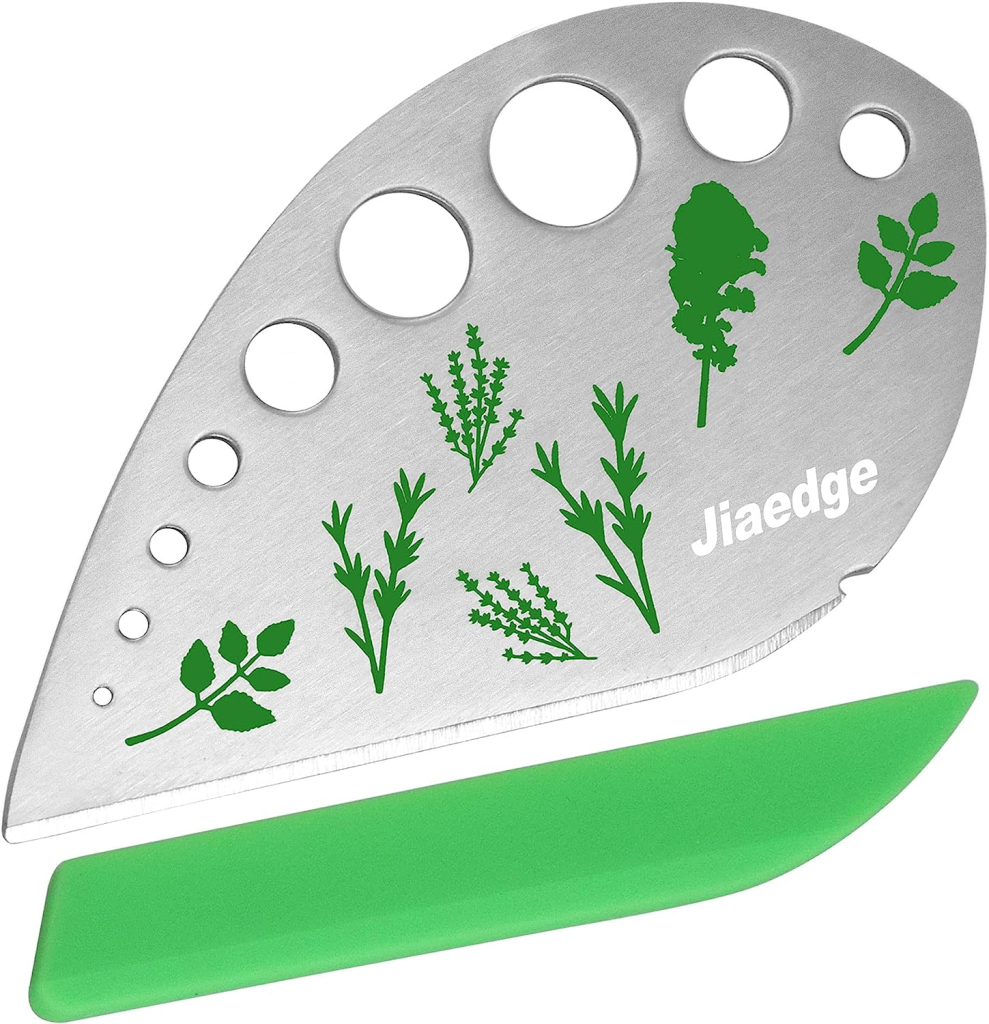When it comes to fresh herbs and dried herbs, there’s no contest. Fresh herbs are irreplaceable in raw dishes like salads, dressings, pesto, and garnishes. They tend to taste better and add more flavor than their dried counterparts. But their biggest drawback is their preparation. Dried herbs come ready to go, but fresh ones require washing, stripping, and chopping. This process can be extremely tedious depending on the herb. But if you love using fresh herbs, meet the herb stripper, an underrated tool that can speed the preparation process.
What is an Herb Stripper?
As so named, herb strippers help remove leaves from stems. They come with different sized holes to fit different herbs. You simply place the stem on one side of the smallest hole it’ll fit into and pull it through until all the leaves come off. Some strippers have holes large enough to strip kale or other leafy vegetables. Some types can also come with a blade so you can strip and chop herbs with the same utensil. Others have bowls attached to catch the leaves as they go through the holes.

This tool can be a game changer for people who cook with fresh herbs. They may even be inspired to use herbs more often after seeing how quickly the stripper works. It may even encourage home chefs to experiment with new herbs for the first time. So here are some tips you should keep in mind.
To start, when you buy a bunch of fresh herbs, promptly wash and dry them to remove any bugs or dirt. Then, wrap the herbs with paper towels and put them into sealable bags. The paper towels will help maintain freshness, but use the herbs within a few days to get the most out of their flavor. Fortunately, there are so many ways to enjoy their unique tastes.
Types of Fresh Herbs and How to Use Them
Basil – This is one of the most popular herbs, perhaps due to its sweet and slightly peppery flavor. It’s commonly found in Mediterranean recipes but it can complement other cuisines as well. Not to mention it’s the most popular herb for pesto. To get the most out of basil, add the leaves (not the stems) toward the end of the cooking process, whether you are making fish, poultry, or a homemade pasta sauce.
Rosemary – Rosemary is a tough herb to prepare, which makes it ideal for the herb stripper. But the leaves impart an amazing woody and pine-like flavor. That makes it perfect for meals like lamb chops, chicken, roast beef, and roasted potatoes. But it’s also delicious on flatbread, sweet potato fries, and even in cake.
Cilantro – Also known as the coriander leaf, cilantro is a controversial herb. Some people love the bright and zesty flavor and some complain it tastes like soap. But it’s a staple in Asian and Latin American food. Cilantro is delicious raw and cooked, and it’s tasty without being too overpowering.
Dill – Dill is commonly found in German and Scandinavian cooking. It’s a delicate herb with a strong, fresh, earthy flavor. It pairs well with many foods, such as poultry, yogurt, seafood, salad, soup, and egg dishes like quiche.
Marjoram – Marjoram can taste like a milder variation of oregano but it’s still intense. It can pair excellently with vegetables and meat but it also can enhance salads, soups, sauces, fish, and other recipes. While you use the leaves for these dishes, save the stems to bring out the flavor in a stock or soup.
Thyme – Thyme is found all over French cuisine. It can enhance dishes with its floral aroma and strong taste that doesn’t overpower other flavors. Like rosemary, a herb stripper can make preparing thyme a breeze. Add it to roast chicken, bread, potatoes, and cocktails.
Mint – Many people only think of mint when it comes to teas and desserts but there are more ways to enjoy this herb. Try it with savory dishes like salad, chicken, curry, and sandwiches. You can also use it to top a fruit salad.
Parsley – Parsley is another versatile and popular herb due to its fresh and subtle flavor. While the leaves are the most potent, the stems can also contribute to a dish. Use it as a garnish to season a soup or to enhance a salad. The possibilities are pretty endless, but parsley is especially delicious with pasta, butter, eggs, and lemon.
Oregano – Oregano has a strong flavor that is quintessential to recipes like chili pasta and pizza sauces. Unlike herbs like basil, oregano can withstand heat, so you can add it toward the beginning of the cooking process. But remember to exercise restraint with oregano so it won’t overwhelm the other ingredients. Keep the stems to add flavor to stocks and soups.




